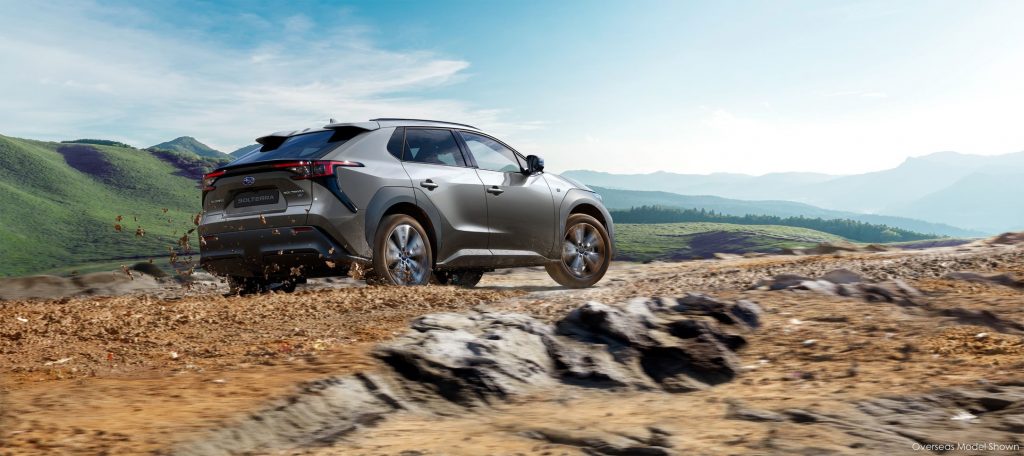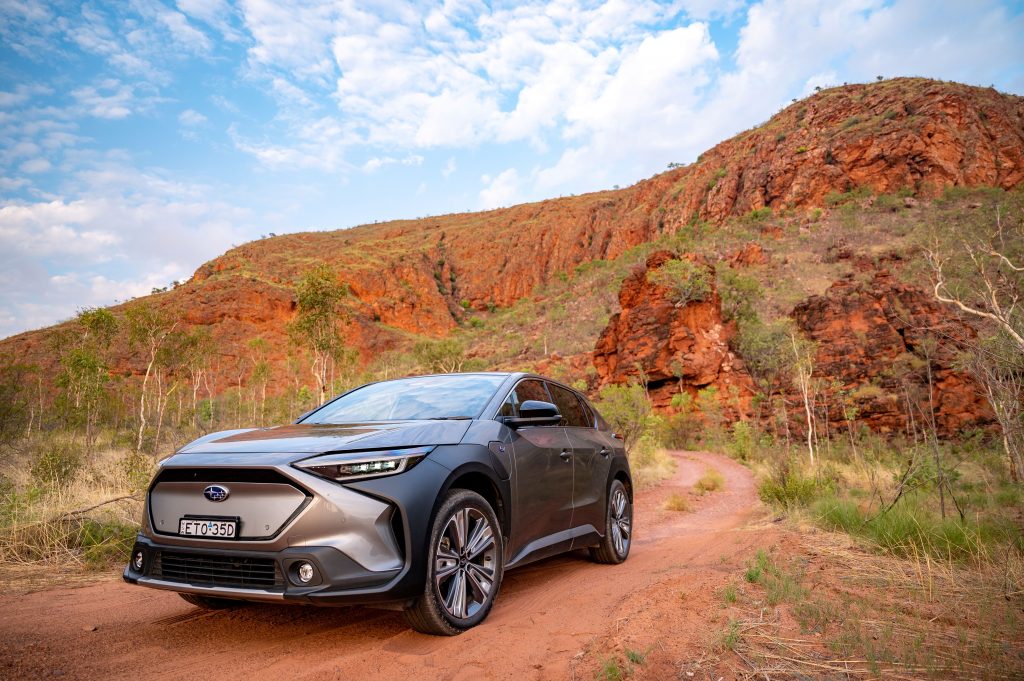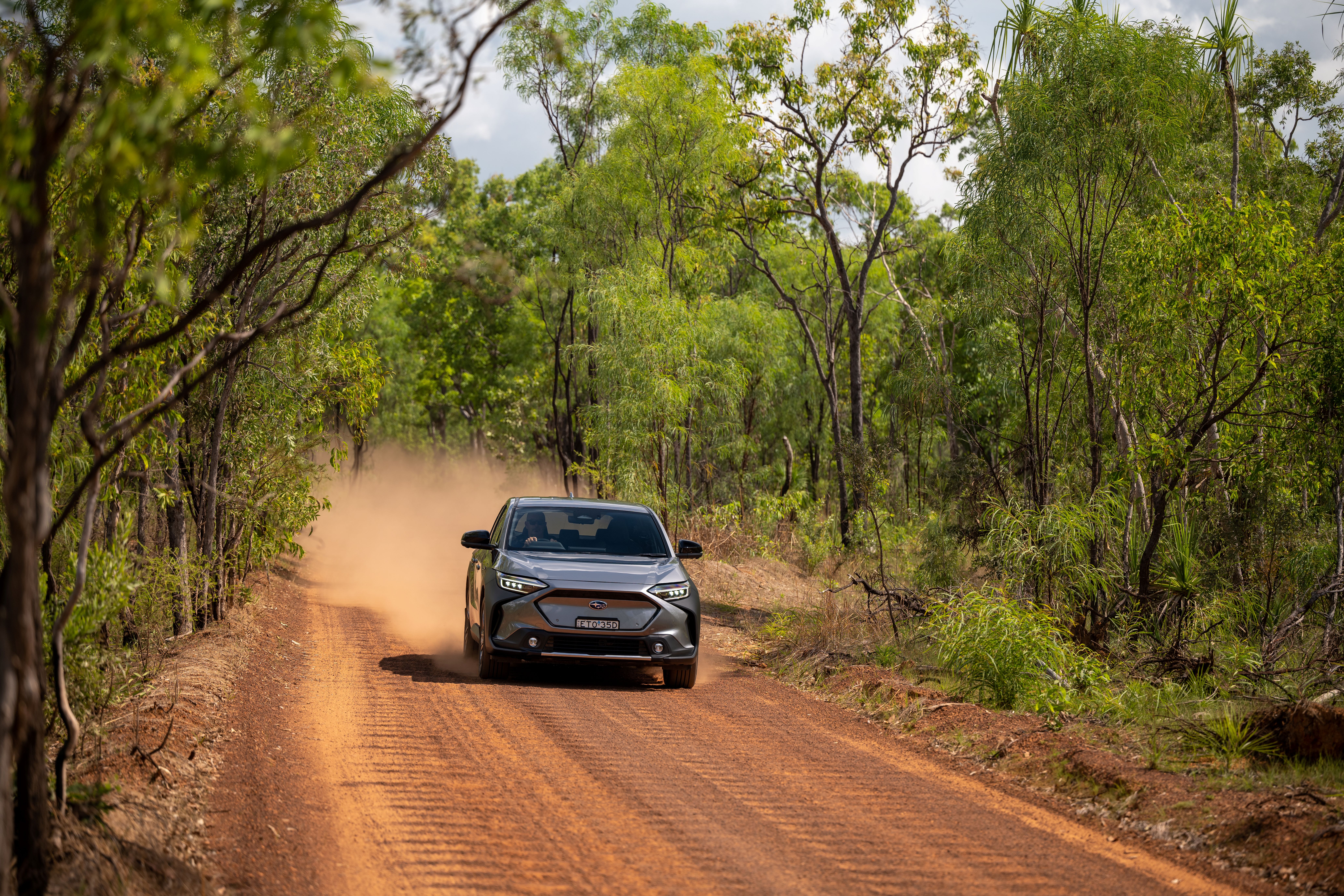Chris Riley tests the 2024 Subaru Solterra AWD Touring EV SUV with pricing, specs, ride and handling, safety, verdict and everything the over-50 driver needs to know.
Summary: The Subaru Solterra lacks almost everything that makes a Subaru a Subaru, so how will it attract customers?
2024 Subaru Solterra AWD Touring EV SUV
Pricing: $76,990 (plus on road costs)
Options: two-tone paint, $1200
Warranty: Five-years, unlimited km, five years roadside assist; battery, eight-years, 160,000km
Safety: 5-star ANCAP (2022)
Engine: electric permanent magnet
Service intervals: 12 months or 15,000km
Power: 160kW
Torque: 169Nm
Transmission: single speed reduction gear, all-wheel drive
Body: 4690mm (long); 1860mm (wide); 1650mm (high)
Build country: Japan
Kerb weight: 1930-2020kg
Towing capacity: not stated
Luggage storage: 410L (seats up), 1798L (seats folded)
Wheels: 20-inch alloy
Tyres: 235/50R20
Spare wheel: tyre repair kit
Ground clearance: 212mm
Turning circle: 12.2m
Battery: 74kWh
Claimed range: 375km
Charging time: 35 hours (standard power point)
Consumption: 18.1kWh/100km)
Consumption on test: 18.6kWh/100km (500+km)
seniordriveraus consumption on test: not tested

[review]
Let’s be frank.
Subaru’s first, fully-electric vehicle, the Solterra is basically a rebadged Toyota bZ4X.
Named for the sun and earth, it’s the second collaborative effort by the two car makers after the Toyota 86/Subaru BRZ sports coupe.
Unlike the coupe, however, which is powered by Sooby’s boxer engine, you’ll struggle to find anything uniquely Subaru about the Solterra.
The junior partner in the relationship, Subaru reportedly had input into the car’s safety and all-wheel drive systems.
The mid-sized, five-seat SUV went on sale in mid-2022 in Japan, US, Canada, Europe, and China, but didn’t make it here until March this year.
Obviously, the two cars look a little different, while the Subaru is offered in all-wheel drive form only – that is, at least in this country.
In Japan (cough) it’s also offered with front-wheel drive.

Subaru claims ownership of the car’s e-Subaru Global Platform (e-SGP) but in reality, it’s just another name for the Toyota e-TNGA platform.
That’s about the size of it.

What’s it cost?
The major differences in styling can be found at the front where Subaru has adopted a blunter face for the Solterra, with a hexagonal-style grille opening plus the addition of fog lights either side of the lower air intake.
Bonnet, front guards and wheel arch flares remain the same to reduce production costs.
At the rear the changes are even more minimal, with alterations confined to the tailgate area.
Ironically, it’s the Toyota that scores a fashionable light bar across the back. Subaru pioneered the linked tail light look way back in the 1990s.
Inside, the finish is clean and modern, but it all looks very much Toyota, including the landscape-style touchscreen instead of Subaru’s favoured portrait screen.
Solterra ain’t cheap either, offered in two grades: AWD and Touring, priced from $69,990 and $76,990 respectively – plus on-road costs.
Two-tone paint is available as a $1200 option with Touring.
Entry AWD runs on 18-inch rims (alloys with wheel covers) and low roll resistance rubber.
It is equipped with dusk-sensing, self-levelling LED headlights, LED tail lights, powered-fold mirrors, puddle lights, powered-operated tailgate, roof rails and roof carrier brackets.

Inside, there’s cloth trim and dual-zone climate control with rear air vents, heated leather steering wheel, heated front and outer rear seats, eight-way power-adjust driver seat with lumbar support, plus a mat set and cargo tray protector.
Touring adds larger, 20-inch wheels, synthetic leather, panoramic glass roof, power adjustment for the front passenger, auto-dipping door mirrors and door mirror memory for the driver.
A digital rear vision mirror replaces a conventional mirror in both, bypassing the heads and headrests that usually block rear vision.
In terms of infotainment, both grades feature a 12.3-inch touchscreen with built-in navigation, AM/FM and DAB+ digital radio, wireless Apple CarPlay and Android Auto, plus Bluetooth with voice control and audio streaming.
The base model gets six-speaker sound, while Touring benefits from premium 10-speaker Harman Kardon audio, with a separate subwoofer and amplifier.
Wireless phone charging is confined to the more expensive grade.
There are two USB-C ports front and back, plus a single USB-A port and 12V/120W outlet at the front.

Solterra scores a full five-star ANCAP safety rating.
There are front, side and curtain airbags as well as a front seat centre bag to stop heads from bumping.
Subaru’s hallmark Eyesight system has made way for what’s called Subaru Safety Sense, with support for adaptive cruise control and autonomous emergency braking.
There’s also emergency steering and brake assist, lane departure warning and lane tracking assist, road sign recognition and speed limiter.
Vision Assist incorporates adaptive high beam, blind spot monitor, front and rear parking sensors and parking brake support, with rear cross traffic alert, safe exit assist and a 360-degree view monitor.
Touring adds advanced parking assistance via displays and alerts.
There are three rear top-tether and two ISOFix child-seat anchors.
The price for both grades includes a five-year unlimited kilometre warranty, complimentary five-year service plan (60 months/75,000km), five-year roadside assistance, 2kW (8A) AC charging cable with 10A wall plug for charging.
The high voltage battery is covered by an eight-year/160,000km warranty.
Subaru’s Map Update Program provides map updates for the first three years.

What’s it go like?
Solterra is about the same size as a RAV4, but with the interior space of a Land Cruiser 300 Series.
That’s good news for passengers, with plenty of room in the back and a luggage area that is neither small nor large.
The dash is trimmed in a coarse Berber-style fabric that might look swish, but is likely to attract dirt and dust (and might not look quite as flash in a couple of years).
There’s no glovebox, but the two-tier centre console offers extended storage space and is topped by a sliding armrest.
We found the manual buried in the boot along with the home charging cable.
And, before you ask, there’s no additional storage available under the bonnet as is the case with many EVs.

Taking a leaf out of Peugeot’s playbook, a separate 7.0-inch digital cluster sits elevated above the level of the steering wheel, negating the need for heads-up display to some extent.
The large touchscreen incorporates push-buttons for audio volume and the like, with separate buttons for temperature, fan and air-flow settings.
Why do car makers feel the need to fit complex digital mirrors, when a standard rear vision mirror will suffice?
The switch that normally toggles between day and night changes between the digital and standard formats, and while the digital mirror may offer some benefits it is difficult to focus on quickly, especially with multi-focal glasses.
The navigation software lags and the screen does not respond to destination entry at times.
We quickly switched to Android Auto but it was plagued with constant disconnects.
Then there’s the stupid bloody eye on the wheel that monitors for signs of fatigue or lack of concentration.
If it can’t see your face, it starts complaining relentlessly.
For Pete’s sake!
Solterra features two electric motors, one for each axle, which delivers its all-wheel drive ability.
Individually, they deliver 80kW and 168.5Nm, but together produce a combined 160kW of power and 337Nm of torque.
That’s less power and torque than a WRX for example, while Solterra weighs another 500+kg.
Power is supplied by a 71.4kWh lithium-ion battery, with energy consumption a claimed 18.1kWh/100km.
The dash from zero to 100km/h takes around 6.9 seconds, which is a bit pedestrian compared to other electric vehicles.
In contrast, the single motor fitted to the Toyota front-wheel drive version delivers 150kW of power.
Imagine what Subaru could do with two of these babies working in tandem.
Could we see a Solterra WRX?
Range depends largely on the size of wheel fitted to the vehicle.
Entry AWD with 18-inch wheels is good for 416km, while Touring, with 20-inch spinners, has a reduced range of 357km (both figures WLTP).
This latter item of information does not seem to have been publicised widely and came as a surprise.
Unfortunately, the larger EV batteries become, the more redundant home charging cables are becoming.
In this case it takes 35 hours to charge Solterra from zero to 100 percent with a 10A household power point.
With three phase power and an 11kW wallbox, this figure is reduced to 9.5 hours. In other words, basically overnight.
Using a commercial DC fast charger, at a rate of up to 150kW, charging from zero to 80 percent can be achieved in as little as 30 minutes.
However, it’s not advised to fully charge the battery repeatedly this way as it is likely to reduce battery life (and battery packs are super expensive to replace).

In terms of driving, Solterra feels overly large and heavy, with steering that is light and twitchy if you don’t watch it.
Acceleration is brisk, with plenty there for overtaking, but probably feels quicker than it is because of the instant torque.
Handling and ride quality are surprisingly good, but the electric power-assisted rack-and-pinion steering lacks feedback and the car feels isolated from the road.
Three drive modes are offered – Normal, Power and Eco.
There’s also a two-mode version of X-mode which coordinates engine, transmission, brakes and all-wheel drive – to negotiate “almost any” terrain.
At the touch of a button on the centre console, one of two modes can be activated: Snow/Dirt or Deep Snow/Mud.
Ironically, the Toyota offers three X-modes.
A range of regenerative braking levels are available via the steering wheel paddles, right down to but not quite one-pedal driving – it won’t bring you to a complete stop.
The level of braking is reflected in a series of chevrons next to the D symbol, while a green icon appears when maximum braking is selected.
Counter-intuitively, the minus paddle increases braking resistance, while plus decreases it.
In the event of a flat tyre, a puncture repair kit is provided in lieu of a spare wheel.
You’ll need a proper spare wheel if you plan to go off road.
After more than 500km of mixed driving, including a run up the coast and back, we were getting energy consumption of 18.6kWh/100km.
What we like
- Five-star safety
- Charge socket at front
- Push-buttons for audio volume and the like
- All-new version of X-Mode
What we don’t like
- Too expensive
- Needs greater driving range
- No glovebox
- Digital rear-view mirror
- Bulbous wheel arches
- Steering light on feedback
What over-50s need to know
Some EVs drive better than others.
But, at the end of the day, it comes down to a question of price and driving range. They’re what matter most.
Subaru’s Solterra is relatively expensive and doesn’t go nearly far enough on a single charge.
What’s more, it lacks character, and looks and feels more Toyota than Subaru.
There’s no boxer engine and it lacks the signature engine note that Sooby drivers prize, nor is it any great shakes off the line.
Sure, it’s got all-wheel drive and X-Mode, but is that really enough?
Subaru’s biggest sellers are Forester, followed by Crosstrek and Outback in equal measures.
Solterra is nothing like these vehicles, nor any other Subaru and this could be a bigger stumbling block than the company might think.
Still, older drivers seem to be drawn to the brand – so who knows?

seniordriver comments
Platform sharing is a fact of life, but it comes with some problems. People (especially over-50s) are loyal to the Subaru brand, often buying model after model over a number of years, but it’s hard to see why a dedicated Subaru fan would be attracted to the Solterra.
At least the Solterra has Subaru’s traditional all-wheel drive.
The locating of the digital cluster above the steering wheel is similar to the Peugeot approach, and one we’re not fans of. It is claimed to reduce the need for a head-up display but we find it difficult to use and anti-intuitive. It is possible users will come to grips with it over a longer period, but they really shouldn’t have to.
Buyers should be made aware of the reduced (and paltry) 357km range for the Touring. As we’ve said before, it is usually recommended that charging only be up to 80 percent. Eighty percent of 357 is 286km. Most owners won’t want to let the battery charge fall much below 20 percent, so the range comes down to 229km. If you can live with that (and assuming the digital readout is accurate) then you should be fine.
Oh, and don’t forget to factor in that charging the battery from zero to 100 percent will take a whopping 35 hours using a 10A power point. Even using an 11kW wallbox will see you plugged in for 9.5 hours.
